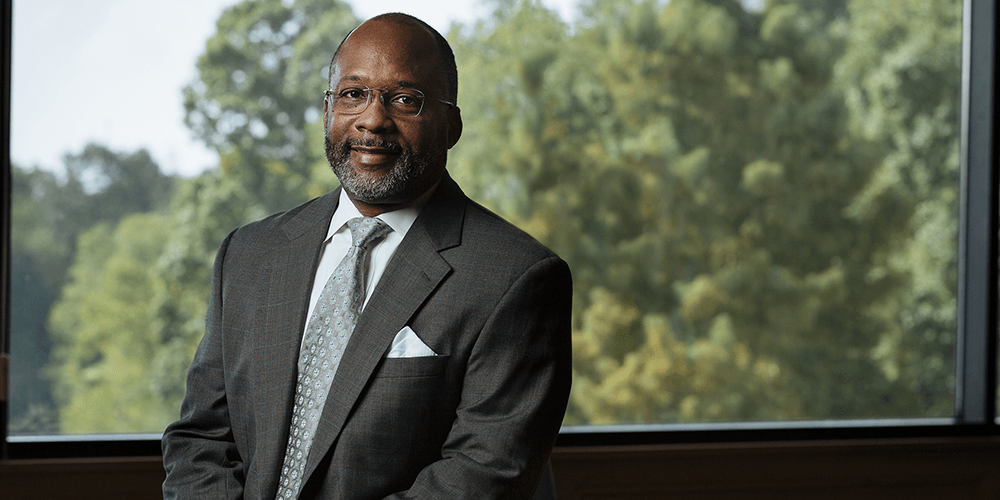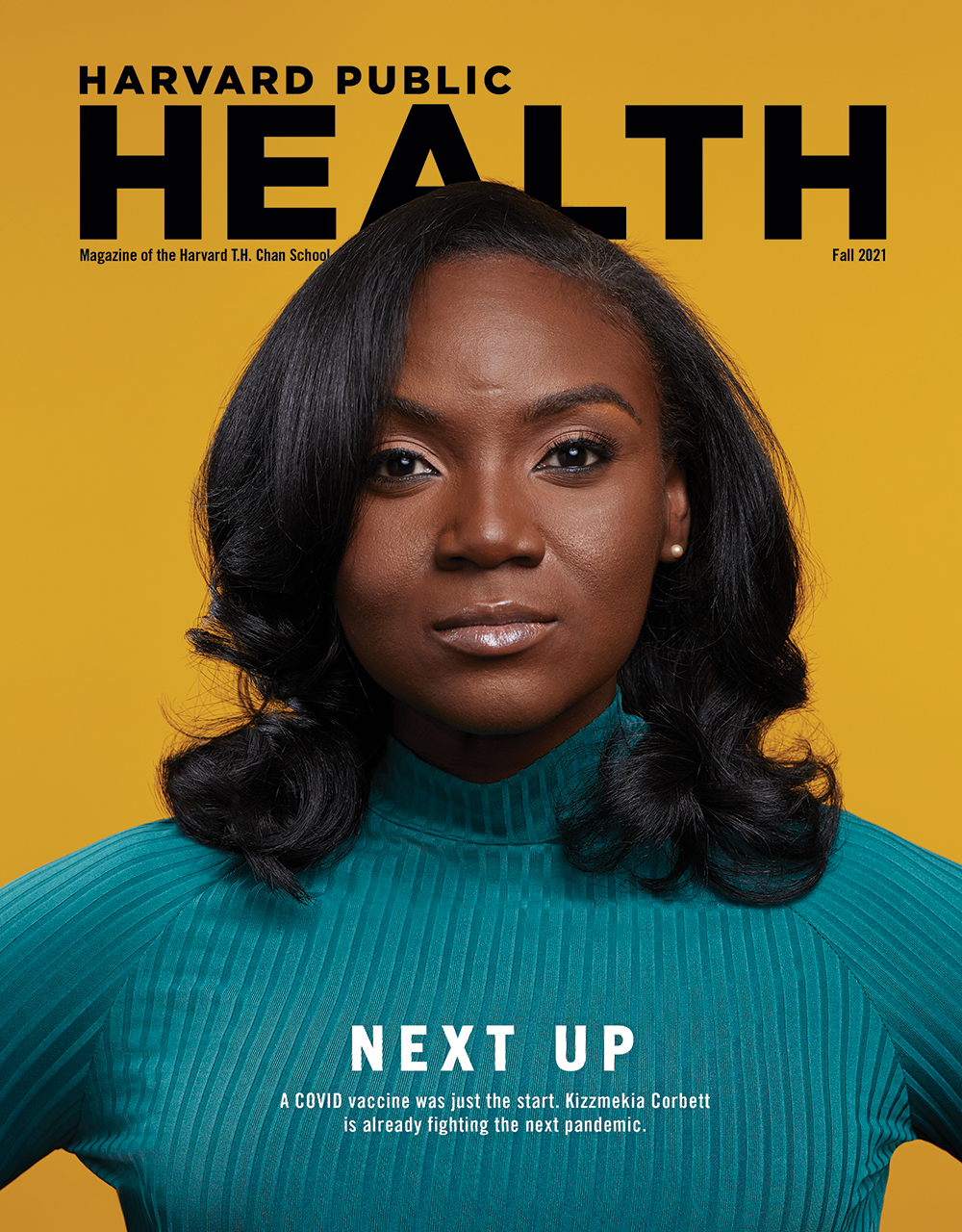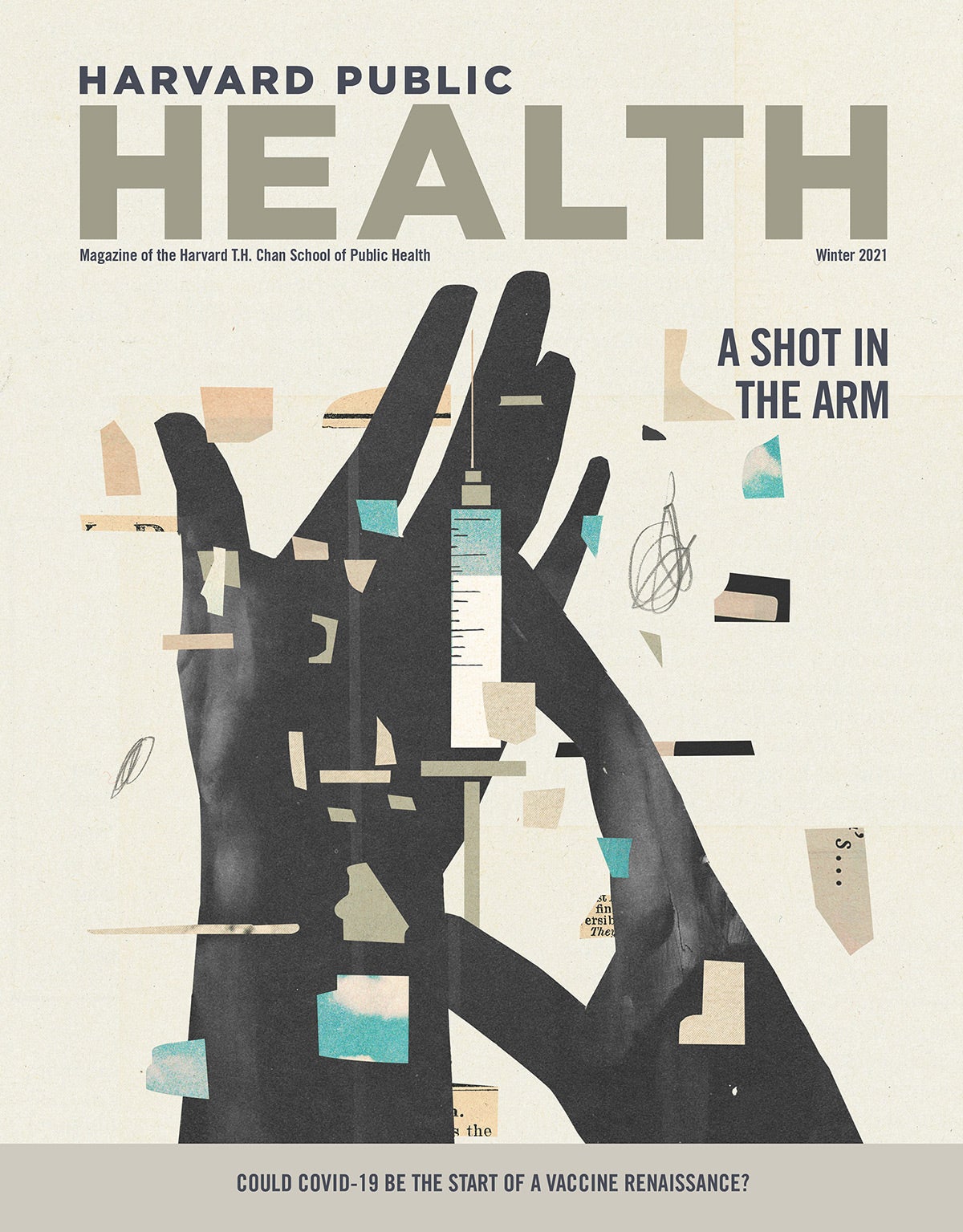
Vindell Washington, SM ’05, is on a mission to revolutionize medical care with electronic health records.
In 1994, the U.S. Army called up physician Vindell Washington to serve in Haiti as a captain in the 28th Combat Support Hospital, an emergency department in support of the 82nd Airborne Division. The American invasion to remove Haiti’s military regime soon ended, but the soldiers stayed on in the teeming capital of Port-au-Prince for peacekeeping missions.
Washington, SM ’05, was—and still is—a tech head. When a patient came in with a strange set of symptoms—rash, low-grade fever, and disorientation—Washington was first in line to use a prototype satellite hookup on the roof of a Humvee to communicate with physicians at Walter Reed Army Medical Center, in Washington, D.C. Within minutes, Washington convened several specialists who together diagnosed the soldier with porphyria, a rare and sometimes disabling disorder of the skin and nerves. The soldier was airlifted out of the country for treatment.
“It immediately struck me that if we didn’t have that technology, we’d be sending him home with a question mark,” Washington says. “Once you have access to any technology that allows you to significantly improve patient outcomes, you never want to go back.”
Since that insight, Washington has devoted his career to evangelizing about the power of information technology to transform medical care. From the summer of 2016 until this past January, he led the Office of the National Coordinator for Health Information Technology (ONC), in charge of overseeing the adoption of health information technology and electronic health records, or EHRs—the keystone of his vision for the future of health care.
Introduced at the Mayo Clinic more than 50 years ago, EHRs are the equivalent of a digital chart, following patients wherever they receive care and giving doctors crucial background on everything from past hospitalizations to drug allergies. When they work as intended, EHRs can avert misdiagnoses, reduce costs, and ensure the most scientifically up-to-date interventions.
But they’ve been slow to catch on. Even though 95 percent of hospitals and 75 percent of medical practices currently use electronic records, the technology’s full impact has been hamstrung by technical incompatibilities, resistance from some doctors, and lack of investment from hospitals. “When it comes time for systems to invest, they would rather build a new hospital wing than redo their electronic systems,” Washington laments. “It’s always number 12 on a list of 10.”
LAUNCHING A REVOLUTION
Despite the institutional foot-dragging, Washington contends that electronic records could launch a transformative “learning health system” that would integrate patient information, population-level health data, and the latest scientific findings. “Data is the lifeblood of the value-based payment environment,” he wrote this past January in the Health Affairs blog, referring by “value-based” to accountable care organizations, a model designed under the Affordable Care Act to improve quality and slow spending growth, as opposed to the expensive fee-for-service system entrenched in the U.S. “The goal is to use the information from each patient encounter to make the next encounter better—across the entire health care system.”
Learning health systems operate on a continuous feedback loop in which scientific evidence informs patient care, and data gathered from patient care inform scientific investigations. These systems were spurred, in part, by long-standing concerns that many current treatments are not fully supported by high-quality evidence, and by reports about harms caused by medical errors and avoidable shortcomings in treatment.
A learning health system could speed the translation of basic research into clinical practice. Currently, it takes about 17 years for a laboratory or public health discovery to be adopted widely into practice. “Say the NIH has discovered a marker for breast cancer or colon cancer,” says Washington. “You don’t want to wait 17 years before the discovery gets into wide practice. You want to get it to the bedside as quickly as possible.”
—Vindell Washington, SM ’05
For example, a learning health system could use real-time patient data generated from an Apple Watch or Fitbit. “When I was a resident, doctors would tell patients to bring back a list of blood pressure readings or blood sugar readings. Today, that information is gathered electronically,” Washington says. “You can imagine a scenario where I just had hip replacement surgery, and I need at least 750 steps today and 1,000 steps tomorrow and 1,500 steps the day after that to ensure a good rehab. All that information could be fed to my care team through the Apple Watch on my wrist—and if I am struggling and only managed 50 steps today, someone could reach out to me.” Similarly, a doctor could access real-time data on air pollution levels in a patient’s neighborhood, reaching out proactively when a patient is at risk.
Learning health systems may also someday draw on individual genetic profiles. If a patient has high blood pressure, for instance, the latest algorithms for care suggest starting with an ACE [angiotensin converting enzyme] inhibitor. But for patients with certain genetic markers, that’s not always the appropriate treatment. “We know that African-Americans often respond better to diuretics than to ACE inhibitors,” Washington says, “but not everyone who is brown-skinned has the same genetic marker. In the future, you could electronically search for that genetic marker, not just follow a cookie-cutter algorithm.”
Ultimately, a learning health system could speed the translation of basic research into clinical practice. Currently, it takes about 17 years for a laboratory or public health discovery to become adopted widely into practice. “Say the NIH [National Institutes of Health] has discovered a marker for breast cancer or colon cancer. You don’t want to wait 17 years before the discovery gets into wide practice. You want to get it to the bedside as quickly as possible,” Washington says.
“We’re not talking about science fiction,” he adds. “There is an amazing set of possibilities right now.”
DOCTOR TO DATA GATHERER
Washington talks with a warm bedside manner, as self-deprecating about his own accomplishments as he is passionate about the potential for medical technology. Growing up in Fredericksburg, Virginia, however, he had a bit of a daredevil streak, dreaming of becoming an Apache helicopter pilot in the Army. He attended Penn State on an ROTC scholarship before going on to the University of Virginia School of Medicine, where he was drawn to emergency medicine for the immediate impact it could have on someone’s life. “In a short time, you can take someone who is on death’s door and pull them back to stability,” he says.
Early in his career, Washington realized the impact technology could have. As a resident at the Hennepin County Medical Center after medical school, he kept track of complex algorithms for drug doses on the best technology he had at the time: a Casio Personal Digital Assistant, designed to keep track of addresses and phone numbers. Later, as a doctor, he upgraded to a PalmPilot for the same purpose. “I remember always feeling that time was of the essence and that having some of the complex drug regimens for difficult cases in my pocket—and not at the doctor’s station—was a big deal.”
Re-entering civilian life after his Army stint, he quickly realized that he could multiply his impact as an administrator. Washington led an emergency medicine group in Charlotte, North Carolina, where he started a business based on improvements to the group’s billing and coding systems. Seeking to expand the company, he began searching for investors but became bewildered with all their talk of “venture capital” and “mezzanine investors” and “growth strategies.” “I had no idea what they were talking about.” he remembers.
To gain more business sense, he enrolled in 2003 in the master of health care management program at the Harvard T.H. Chan School of Public Health, a two-year, part-time program designed to get physicians up to speed on financial literacy and business strategy.
Washington was especially struck by the courses on business strategy. Like most doctors, he had been trained in the classic “see one, do one, teach one” model of apprenticeship, which passes techniques down from mentor to student. Even as a young physician, Washington had questioned that system, wondering why, for example, doctors in medical school at the University of Virginia tied in chest tubes one way and doctors at his residency program at the Hennepin County Medical Center tied them in another way. Suddenly, his classes were giving him new analytical tools to take a broader view on gathering data and figuring out the best path. “It was a paradigm shift,” he says.
CLEARING A PATH FOR HEALTH TECHNOLOGY
After graduating from the School, Washington sold the company he had helped create and began consulting on implementing health technology around the country. In 2009, Harvard Chan classmate Stephanie Mills recruited him to become chief medical information officer for Franciscan Missionaries of Our Lady Health System Medical Group in Baton Rouge, Louisiana. Washington’s work there eventually caught the attention of Karen DeSalvo, SM ’02, then the ONC director, who had worked with him on a new electronic health system in New Orleans in the wake of Hurricane Katrina—a crucial priority for the city, whose poor and minority residents were scattered and displaced in the wake of the disaster.
“Vindell was a great mentor to me in helping me think about how we could blend the technical and medical aspects with the social mission and affordability,” she says. “He is one of those people who you put in a room and even if he doesn’t know people, he is able to shape the conversation and help people come to a consensus.”
In 2015, she asked him to come to Washington to help as her deputy as she assumed the role of acting assistant secretary for health in the Department of Health and Human Services. In August 2016, Washington became ONC head. Both left their posts at the end of the Barack Obama administration.
HELPING MEDICAL SYSTEMS “TALK TO ONE ANOTHER”
In his new policy hat, Washington’s watchword was admittedly wonky: “interoperability”—a set of standards that allows different electronic medical systems to talk to one another. To achieve that, he identified three goals.
First, government had to make the business case to health systems for freely exchanging information, ensuring that the incentive payments they received were worth the cost of carrying out the new regulations. Second, he focused on creating common technical standards of exchange between various health IT vendors. Third, he set about creating a culture of exchange that would normalize the flow of digital information. “That’s the hardest of the three, quite frankly,” Washington says. Although he started off targeting education efforts to patients, he quickly realized that it was doctors who needed to change their ways.
Early in his career, Vindell Washington kept track of complex algorithms for drug doses on the best technologies available at the time—a Casio Personal Digital Assistant, and later, a PalmPilot. “I remember always feeling that time was of the essence.”
Physicians have bucked against the extra work placed on already taxed schedules to enter records into the computer, taking time away from their interaction with patients. A 2016 study in the Annals of Internal Medicine found that during office hours, physicians spent nearly 50 percent of their time on electronic health record tasks and desk work—and another one or two hours outside the office on additional computer and clerical work.
Washington believes that the extra workload simply reflects the growing pains of an evolving technology, and that even now the benefits far outweigh the harms. As he said in a 2016 press conference, “I don’t hear anymore about illegible orders from physicians. I don’t hear about missing information.”
One of the most important benefits of health technology, he notes, is the ability to share patient information among different providers, including providers who might be competitors within a particular locale or specialty. Here, his own medical background is invaluable. “If you ask me about the people across town, they’re all good people, but they are clearly practicing inferior medicine,” he jokes. “If a patient asks for their information, a doctor’s response should be an automatic ‘Yes.’ It should not be a confrontation or a call to arms. It’s just the new normal.”
IN POLITICIZED TIMES, A NONPARTISAN GOAL
When a new national administration took over in January, Washington resigned from ONC. In June, he was named chief medical officer for Blue Cross Blue Shield of Louisiana, offering him a new environment in which to carry out his high-tech, patient-centered ambitions. He’s hoping that the momentum he helped create in the capital will be sustained.
Despite the fierce debates this year around health care, electronic health records have been largely excluded from controversy. While some Republican lawmakers have called for a rollback of EHRs, arguing they take control away from doctors, the GOP-led Congress in general supports the technology. In June, the U.S. Department of Veterans Affairs announced it would be overhauling its electronic health records, in the hopes of improving care and reducing wait time for appointments.
Washington sees that as a good sign. “The idea of working towards a free flow of information is nonpartisan,” he says. He looks back on his own early self-apprenticeship in information technology, from satellite hookups on the battlefield to personal digital assistants in the emergency room. “I saw the role technology could play. Wielding new technology in the service of what patients want and need is what I’m most jazzed about.”
Michael Blanding is a Boston-based journalist and author of The Map Thief: The Gripping Story of an Esteemed Rare-Map Dealer Who Made Millions Stealing Priceless Maps.







